Sepia Saturday provides bloggers with an opportunity to share their history through the medium of photographs. Historical photographs of any age or kind become the launchpad for explorations of family history, local history and social history in fact or fiction, poetry or prose, words or further images. If you want to play along, sign up to the link, try to visit as many of the other participants as possible, and have fun.
The prompt photo points us to the letter P, and for me, to the Port of Embarkation in Hoboken, New Jersey, as I continue a series on how the 1918 influenza epidemic affected my families. I have traced Jesse James Bryan, first cousin to my grandfather, Thomas Hoskins, from his early life in Drakesville, Iowa to Camp Merritt in Bergen County, NJ.
 During his time at Camp Merritt, Jesse must have enjoyed some of the many amenities provided to the enlisted men biding their time before sailing to France. Having arrived at Camp Merritt on September 9, Jesse had time to make a trip into NYC, where he had a studio photograph taken and presumably took in some sights of the city.
During his time at Camp Merritt, Jesse must have enjoyed some of the many amenities provided to the enlisted men biding their time before sailing to France. Having arrived at Camp Merritt on September 9, Jesse had time to make a trip into NYC, where he had a studio photograph taken and presumably took in some sights of the city.
Jesse Bryan was assigned to the U. S. troop transport ship America, sailing September 20, 1918. Soldiers came from the three embarkation camps in the area to embark on the America: Camp Merritt, Camp Upton, and Camp Mills. Not all of those soldiers had time for relaxation at a camp as Jesse did. Some had arrived at their embarkation camp on the same day, or the day before, they found themselves at the port in Hoboken, NJ.
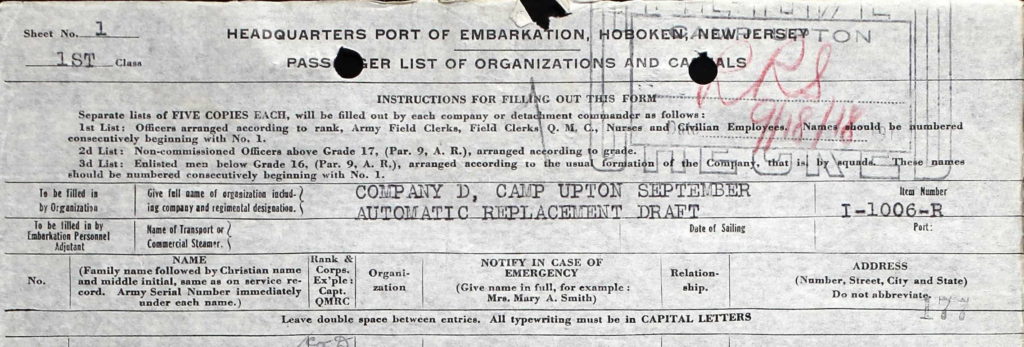
Before deployment, the enlisted men received equipment and supplies for their time on the ship and the beginning of their service in France.
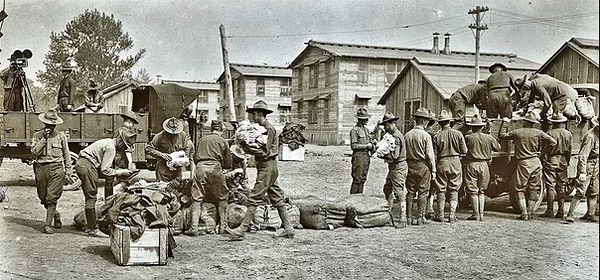
Issuing equipment to troops in staging barracks at Camp Merritt, NJ
prior to deployment to France July 26, 1918
NARA111-SC-15652-ac
Source of Photograph: National Archives RG 111
The backpacks the troops carried were heavy and unwieldy. You can view a short video from The History Channel which shows the contents of the packs and some men trying them out. “The bottom section of the backpack, known as the diaper, was detachable and carried the soldiers blanket, shelter half, and shelter half pole and pins. On the belt you find ammo, a first aid kit, a canteen cover, and a canteen and cup. Inside the flaps were a baking tin, a condiment can, and boxes of bread rations. Also inside the flaps were a towel, soap dish, shaving kit, handkerchief, foot powder, and extra socks. Attached to the outside were the bayonet, shovel, trenching tool, and a mess kit. The entire weight of the pack lies entirely on the soldiers shoulders, making it very uncomfortable. If a soldier wanted to get anything out of his pack, he would have to stop, unravel everything, get what he needs, and then pack everything back up. Due to the placement of the bayonet, most soldiers would have to have a buddy put it back for them.”
 Most troops from Camp Merritt marched in contingents of two to three thousand men, the capacity for one ferry, for an hour to board ferryboats at Alpine Landing that took them to the piers at Hoboken to board troop transports for Europe. Contingents would leave the camp for the landing at half hour intervals to board the ferries for the two hour trip to the embarkation piers where several transports might be loading simultaneously. There they would be joined by troops from Camp Mills and Camp Upton arriving by train at a terminal on Long Island for final transport by ferry to the embarkation piers.
Most troops from Camp Merritt marched in contingents of two to three thousand men, the capacity for one ferry, for an hour to board ferryboats at Alpine Landing that took them to the piers at Hoboken to board troop transports for Europe. Contingents would leave the camp for the landing at half hour intervals to board the ferries for the two hour trip to the embarkation piers where several transports might be loading simultaneously. There they would be joined by troops from Camp Mills and Camp Upton arriving by train at a terminal on Long Island for final transport by ferry to the embarkation piers.
Jesse’s transport ship, America, boarded passengers on September 18-19. Troops left at all hours of the day and night. A quick look at an old newspaper predicts some rain on the 18th, with temperatures in the 70s and fair weather on the 19th. If it did rain, the feet of thousands must have made for a muddy and slippery march. You can see the men with backpacks and rifles in the photos below. The path was not flat and looks a bit treacherous.
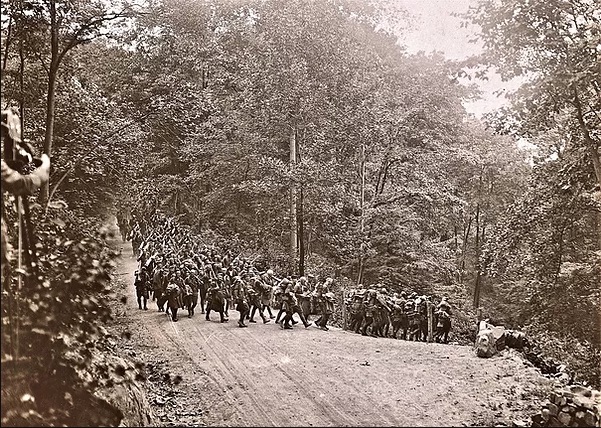
5th Regiment Engineers on the way down to Alpine Landing for ferry boat
to take them to Embarkation Piers at Hoboken, NJ Jul 30, 1918
NARA111-SC-15585-ac
Source of Photograph: National Archives RG 111
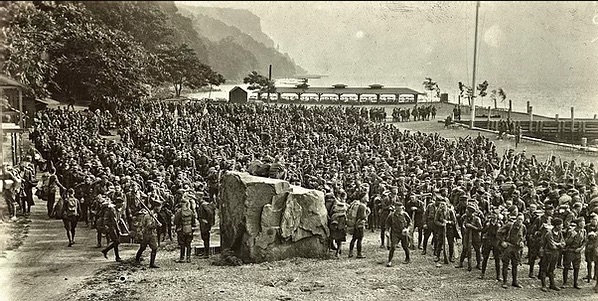
5th Engineers Regiment, 7th Div. waiting at Alpine Landing for Erie Ferry Boat
to take them to Hoboken NJ July 30, 1918
NARA111-SC-15597-ac
Source of Photograph: National Archives RG 111
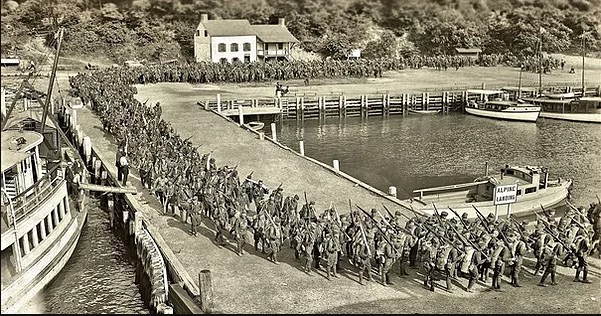
Engineers regiment marching to board their ferry at Alpine Landing, NJ July 30, 1918
NARA111-SC-15599-ac
Source of Photograph: National Archives RG 111
Jesse and 5,175 other passengers embarked on the America. Besides the men enlisted in the September Automatic Draft Replacement, onboard were those assigned to engineering, medical, motorcycle, meat handling, refrigerator plant, chemical warfare, butchery, motor car, radio operator, mess cook, and trench mortar units. There was one civilian onboard – a product expert in the Shoe Section.
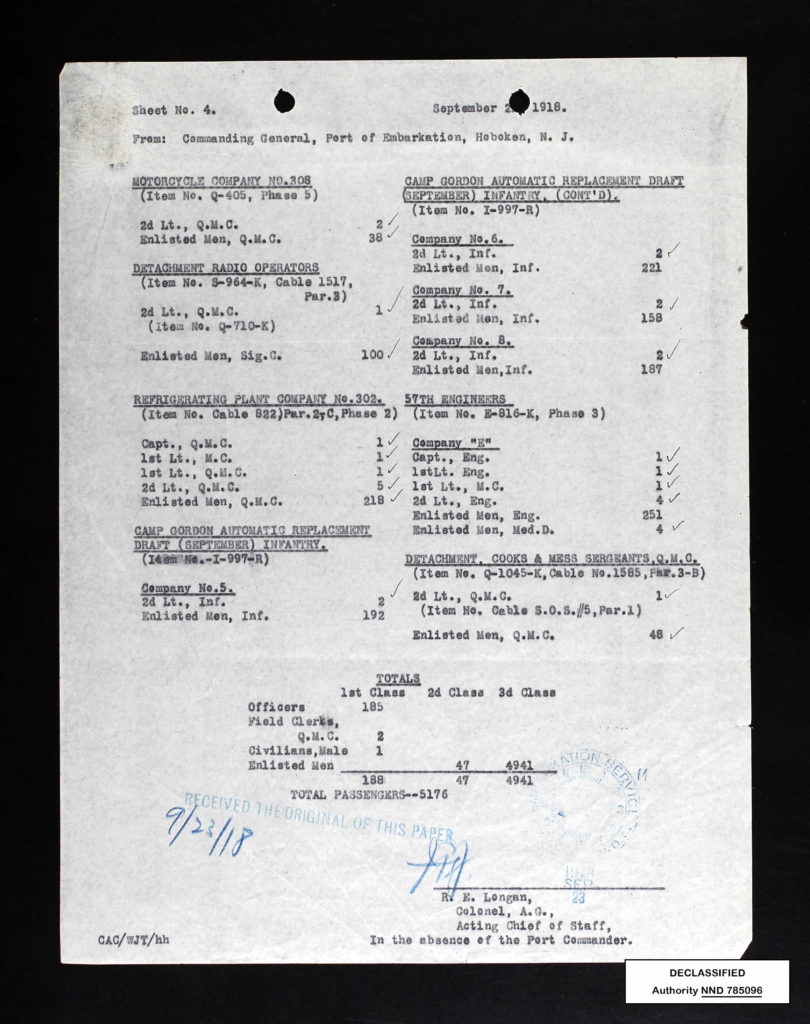
Looking through the passenger list, it was interesting to note that Jesse was with a large number of men from Iowa. Most of them had been with him at Camp Gordon in Georgia as part of the September Automatic Draft Replacement troops. Like Jesse, these men were by and large from small towns and rural areas in Iowa, very few from a city.
Following the hour-long march from Camp Merritt to Alpine Landing, the wait to board a ferry, and the two-hour ferry ride to the port at Hoboken, Jesse and the other men began the process of boarding ship.

Soldiers arriving from Alpine Landing at Hoboken, NJ on Erie Ferry Boat ‘Catskill’ July 30, 1918 NARA111-SC-15601-ac
Source of Photograph: National Archives RG 111
The transport ship America, built in 1905, was originally a luxury passenger liner of the Hamburg-Amerika Line. Hours before the American entry into World War I, the Amerika was seized and placed under control of the United States Shipping Board. Later transferred to the U.S. Navy for use as a troop transport, she was initially commissioned as USS Amerika but her name was soon Anglicized to America.
I’m not one for ocean travel, but the Amerika was certainly well-appointed.
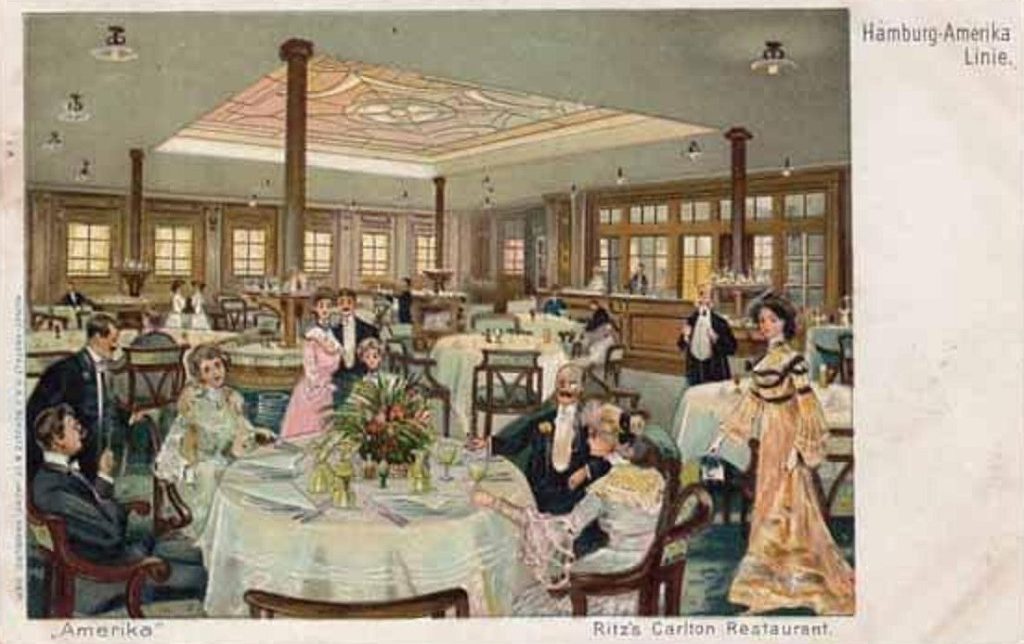
Video tour of the Amerika luxury liner…
Unfortunately for the troops, the America was no longer a luxury liner when they embarked.

The ex-German passenger vessel Amerika, at the Boston Navy Yard, 14 August 1917 shortly after seizure by USSB undergoing conversion for Naval service.
U.S. Navy photo from DANFS
With camouflage, as it would have looked when Jesse embarked.
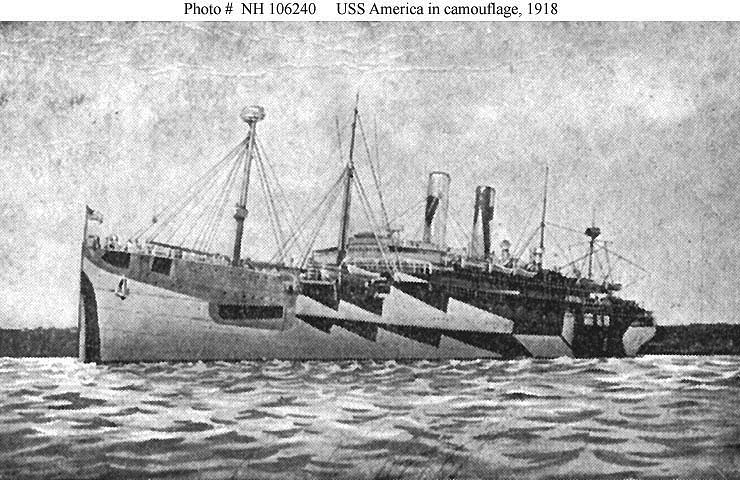
Of course the backdrop to Jesse’s story is the influenza epidemic, with an increasing number of a more lethal flu taking hold in military installations and communities in the northeast mid-September.
Just 10 days after Jesse left Camp Merritt, other contingents left the camp to make the trip to Hoboken. Below are a few excerpts from a newspaper account written by Ernest W. Gibson detailing his experience as an officer of troops who left Camp Merritt on September 29th to embark on the USS Leviathan.

These are just snippets and leave out additional, and tragic, details. The article was found at newspapers.com. The Bethel Courier (Bethel, Vermont) 19 Feb 1920.
And so, with this backdrop, we leave a still healthy Jesse Bryan at the pier in Hoboken, about to board the transport ship America.
Please visit other participants in Sepia Saturday, where they have possibly published posts pertaining to postal personnel or perhaps personal pictures portraying the letter P.

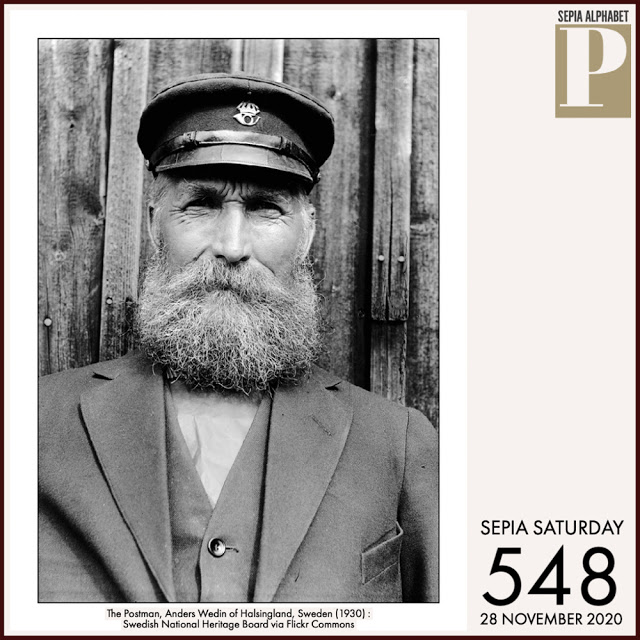
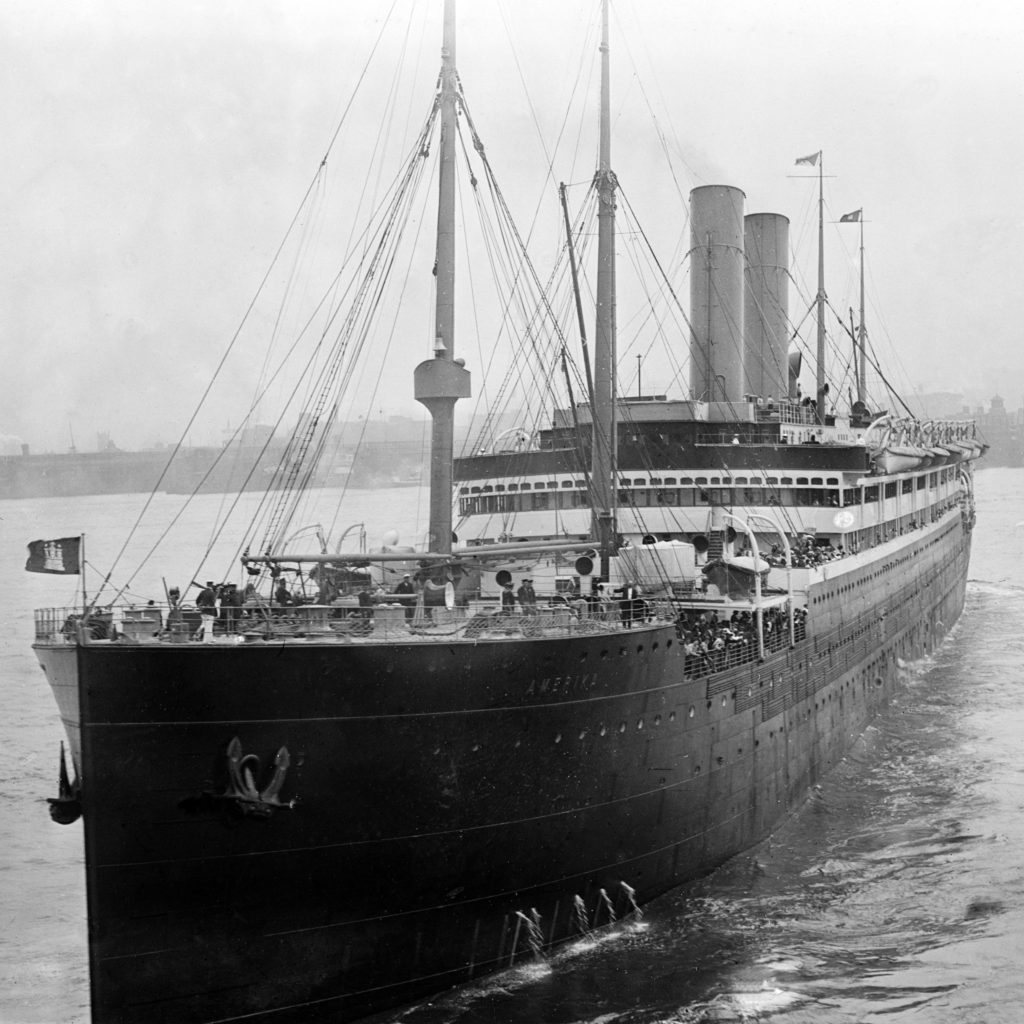



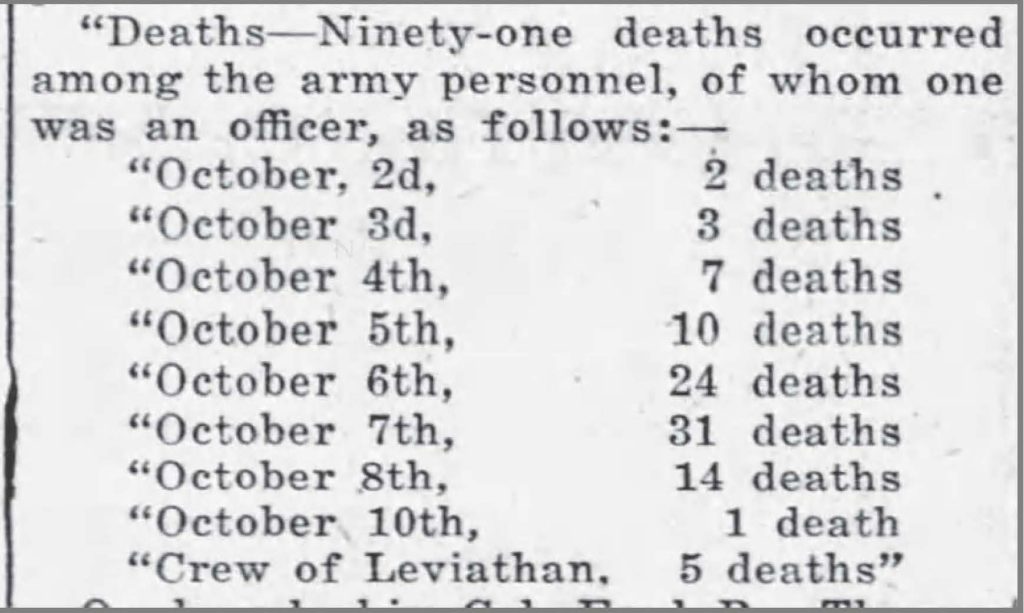
A great story with terrific photos! I imagine many of the men from Iowa must have felt like little more than cattle as they were herded onto the ships. Given our present understanding of contagious diseases, it’s no wonder that influenza spread so easily. That officer’s report of soldiers succumbing to the virus while marching to the ship was horrifying to read. You and Molly have written excellent accounts of how this terrible pandemic of 1918 affected individual people in your family. In some ways the incredible scale of the mortality rates are much easier to understand when examining a single person’s experience. Thank you for creating and sharing this timely series.
A graphic, well researched account of the conditions Jesse faced in 1918, enhanced by impressive photographs and press cuttings. I did like the photograph of Jesse in a much more informal pose than many of those taken fof men about to go,to war.
An absolutely heart-rending post. I was holding my breath looking at the photos of the troops marching to Hoboken, and the ship they were to board, having no idea of the severe illness that awaited them. And then that same bell curve of deaths we have all become familiar with from COVID-19 reports. You have done an excellent job of rendering the military experience of influenza that Jesse went through, while my dad’s Uncle Albert was experiencing the same devastation on the civilian side.
This gives me ideas for more ways to search on my grandfather’s WWI departure and return from France. I do have the ship names and dates now from Ancestry.